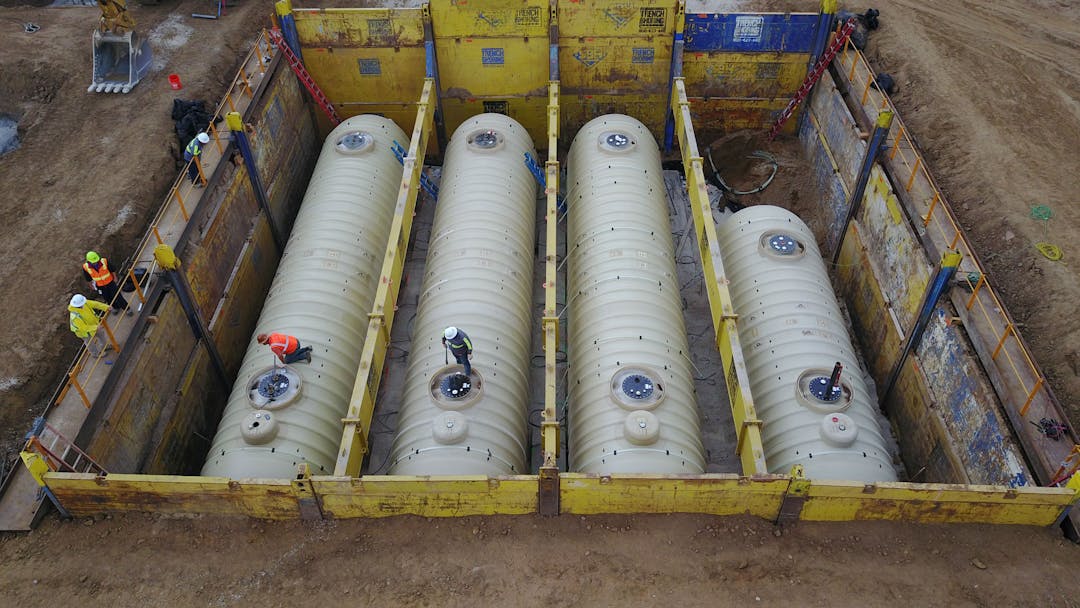Plasti-Fab FRP Flow Control Products: Standard Duty Gates
Plasti-Fab gates are custom made for all of your specific needs.
Stop Gates
Stop Gate and Stop Plate are interchangeable terms used to identify manually lifted gates that are installed in open channels. Stop gates are normally either in or out and do not include a stem or lifting mechanism. Smaller gates or gates with a balance (equalized) head can usually be raised by hand. Larger gates and gates with unbalanced head often require a mechanical lifting device such as a hoist or davit crane.
Stop Gate Design Specifications
Plasti-Fab stop gates are individually molded using fiberglass reinforced polyester resin containing UV inhibitors to the exact size required for each application. Most stop gates utilize a sandwich construction with a closed-cell polyisocyanurate foam core for high strength and corrosion resistance. A totally encapsulate internal steel structural matrix is often used to meet deflection requirements for larger gates. The frames are constructed from Plasti-Fab designed FRP pultrusions with polymeric fiber surfacing material and UV inhibitors for high corrosion resistance. Guides may be embedded, surface mounted or in-channel mounted.
Slide Gate or Penstock
Industrial Slide gates are commonly used in open channel and moderate head applications to isolate equipment, divert flow, close off a wall opening, or cover a pipe that is flush with the wall. Plasti-Fab slide gates are manufactured of gray fiberglass reinforced plastic containing ultraviolet inhibitors. Plasti-Fab penstock is reinforced to withstand the specified maximum operating head. Where required neoprene j-seals can be included to meet low leakage rates. The frames are constructed from Plasti-Fab designed FRP pultrusions with polymeric fiber surfacing material and UV inhibitors for high corrosion resistance.
Slide Gate Hardware and Lifts
The stem and mounting hardware is normally stainless steel and is mechanically operated using a hand-wheel, crank, electric or pneumatically operated lift. Lifts may be mounted on the head rails of a self-contained penstock or on a pedestal or bench stand if the gate is not self-contained. This makes it easier to operate larger gates, gates that are located some distance below the operating surface, or that need to be cycled more frequently.
Downward-Opening Weir Gate
The function of a downward-opening weir gate is to control the upstream water level, and/or pace the amount of discharge from a water system. At times there will be a level control sensor in the system which is directly connected – controlling a modulating electric operator to automatically pace the amount of flow discharged and/or maintain a constant upstream water depth.
Downward-Opening Weir Gate Construction Specifications
Depending on the size of the weir opening and the heads involved, the downward opening weir gate can be constructed as a sandwich style penstock, a one-inch solid FRP gate, or as a Heavy Duty Titeseal gate. If possible, weir gates should be installed to operate with a seating head to obtain the best leakage performance. However, they can also be designed for unseating heads as well. Request a Quote for Weir Gates.
Stop Gate Features
- Individually Molded to the Exact Sizes Specified
- May Be Supplied With or Without Neoprene Seals
- Gates & Guides are UV Stabilized
- Guides May Be Embedded, Surface Mounted or In-Channel Mounted
Slide Gate Features
- Moderate seating and unseating heads from 1 to 25 ft.
- Light weight
- Low leakage
- Superior corrosion resistance
- Built to any size
Downward Opening Weir Gate Features
- Lightweight
- Superior Corrosion Resistance
- Simple to Install
Related Products
Plasti-Fab FRP Flow Control Products: Flap Gates
Flexible neoprene flap gate is the answer for applications requiring corrosion resistant equipment suitable for sea water and most low pH water.
Explore More

Fiber Glass Systems
With manufacturing facilities located around the world, we provide composite piping systems, fittings, and structures to the oil and gas, chemical, marine, offshore, fuel handling, and mining industries.

